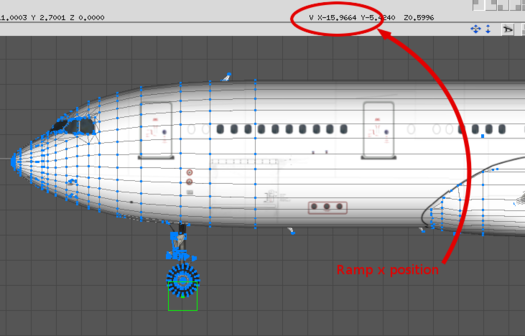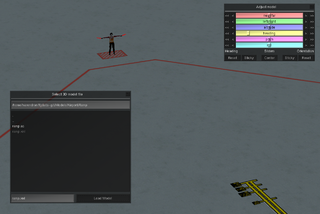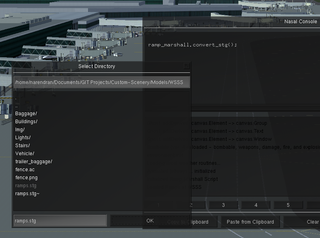Ramp Marshall
Ramp Marshall
A Ramp Marshall is a person who guides aircraft using hand (and wand) signals at a parking ramp. This new feature is now available on a more generalized scale in FlightGear. Until this gets merged into the fgdata repository, you can get this from omega95's fgdata clone or the new Singapore Scenery development.
Currently, support can be added to airports with the ufo but soon, ramp marshalls will be added automatically if a parking spot's flag is set to enable it. This will integrate FlightGear parking positions, ramp marshalls and other features that might come up related to parking ramps or gates.
These are videos of the first prototype of the ramp marshall.
Adding Ramp Marshall Support
Adding Ramp Marshall Compatibility to Aircraft
It's actually very simple to add ramp marshall compatibility to an aircraft, the only file required to be edited is the aircraft's -set.xml file. (or common xml file for aircraft groups) The user is still required to use some kind of 3D modeling program to get the position.
1. Open the Aircraft's model file (containing the gears) with a 3D modeling program and get the x position of the bottom of the nose gear. (Or the position you want to rest at the ramp)
2. Add the following code within the <sim> ... <model> ... </model></sim> tags in the aircraft's -set.xml file. (or common xml file for aircraft groups)
<ramp>
<x-m type="float">-15.9664</x-m>
<class type="string">2</class>
</ramp>
The x position from the 3D model is in the <x-m> tag and the aircraft class is in the <class> tag. With the current models, the aircraft classes are as follows -
- 0 - 747s, 777-300s, A340s, A380s
- 1 - 777-300s, A330-300s, 787s
- 2 - A330-200s, 757s, 767s
- 3 - A320s (includes A318s, A319s and A321s), 737s and other aircraft in general. This works for CRJs, E-jets etc.
This should be all! The ramp marshall should be able to recognize the aircraft and guide it to the right position at the ramp!
Adding Ramp Marshalls to an Airport
NOTE - In the future, this will change because ramp marshall positions are going to be connected to an airport's groundnet.xml file.
1. Start up FlightGear with the ufo at the airport you want to place ramp marshalls.
2. Hit the L key on the keyboard to bring up the model selection dialog and select $FGDATA/Models/Airport/Ramp/ramp.xml. Using the ufo's scenery editing tools, place (and adjust) ramp marshalls everywhere you want. To make it simpler, click on the exact position you want the airplane to come to a stop. This will usually be at the end of a parking ramp's taxiway lines. Then, you will only have to change the heading.
3. Once you've finished placing all the models, hit the D key to dump the stg lines onto the console. (Do not close FlightGear yet) Copy the stg lines into a blank file. (name does not matter)
4. Open up the Nasal console and execute the following function.
ramp_marshall.convert_stg();
5. Choose the stg file you pasted the dumped stg lines in to convert the file into a readable xml ramp position file. The converted file can be found $FGHOME/Export.
6. Copy the exported file (it will be called ramps-export.xml) to $FGDATA/AI/Airports/<icao>/ramps.xml. For example, if you want these ramps at Singapore Changi Intl. Airport (WSSS), you'd put it in $FGDATA/AI/Airports/<icao>/WSSS.xml.
Contributing to the Module
Teach the Ramp Marshall new signals
| Work in progress This article or section will be worked on in the upcoming hours or days. See history for the latest developments. |
Using dfferent models or textures
| Work in progress This article or section will be worked on in the upcoming hours or days. See history for the latest developments. |
Further development
Visual Docking Guidance System
| Work in progress This article or section will be worked on in the upcoming hours or days. See history for the latest developments. |
External Links
- https://gitorious.org/~omega95/fg/omega95s-fgdata
- http://flightgear.org/forums/viewtopic.php?f=30&t=20572
- https://gitorious.org/fg-singapore-scenery


